 W
WThe Colony of Virginia, chartered in 1606 and settled in 1607, was the first enduring English colony in North America, following failed proprietary attempts at settlement on Newfoundland by Sir Humphrey Gilbert in 1583, and the subsequent farther south Roanoke Island by Sir Walter Raleigh in the late 1580s.
 W
WAjacán in the province of Axacan, variants include Xacan, Jacan, Iacan, Axaca, Axacam; was located in the Mid-Atlantic near and including the Chesapeake Bay and present day Virginia, United States. In his 1842 Historia de la Compañía de Jesús en Nueva España, Alegre said Father Juan Bautista de Segura and his companions called the province Axacan.
 W
WThe Ajacán Mission was a Spanish attempt in 1570 to establish a Jesuit mission in the vicinity of the Virginia Peninsula to bring Christianity to the Virginia Indians. The effort to found St. Mary's Mission predated the founding of the English settlement at Jamestown, Virginia, by about 36 years. In February 1571, the entire party was massacred by Indians except Alonso de Olmos. The following year, a Spanish party from Florida went to the area, rescued Alonso, and killed an estimated 20 Indians.
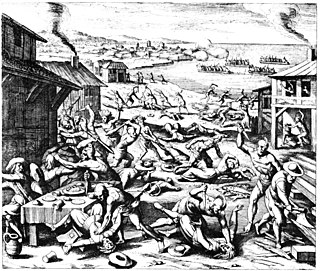 W
WThe Anglo–Powhatan Wars were three wars fought between settlers of the Virginia Colony and Algonquin Indians of the Powhatan Confederacy in the early seventeenth century. The first war started in 1610 and ended in a peace settlement in 1614. The second war lasted from 1622 to 1626. The third war lasted from 1644 until 1646 and ended when Opechancanough was captured and killed. That war resulted in a defined boundary between the Indians and colonial lands that could only be crossed for official business with a special pass. This situation lasted until 1677 and the Treaty of Middle Plantation which established Indian reservations following Bacon's Rebellion.
 W
WBacon's Rebellion was an armed rebellion held by Virginia settlers that took place in 1676. It was led by Nathaniel Bacon against Colonial Governor William Berkeley.
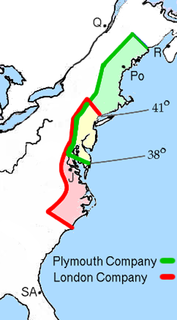 W
WThe First Charter of Virginia, also known as the Charter of 1606, is a document from King James I of England to the Virginia Company assigning land rights to colonists for the stated purpose of propagating the Christian religion. The land is described as coastal Virginia and the islands near to the coast, and stretches from present-day South Carolina to present-day Maine. The patch of land itself would remain the property of the King, with the London Company and the Plymouth Company as the King's tenants, and the settlers as subtenants. The colony's government at first consisted of a council residing in London. The document designated the London Company as responsible for financing the project, which included recruiting settlers and also provided for their transport and supplies.
 W
WThe Chesapeake Colonies were the Colony and Dominion of Virginia, later the Commonwealth of Virginia, and Province of Maryland, later Maryland, both colonies located in British America and centered on the Chesapeake Bay. Settlements of the Chesapeake region grew slowly due to diseases such as malaria. Most of these settlers were male immigrants from England who died soon after their arrival. Due to the majority of men, eligible women did not remain single for long. The native-born population eventually became immune to the Chesapeake diseases and these colonies were able to continue through all the hardships.
 W
WClaude Moore Colonial Farm, originally Turkey Run Farm, was a U.S. park in Virginia recreating and reenacting life on a tenant farm c. 1771. The park permanently closed on December 21, 2018.
 W
WThe Congress or Council of Alexandria was a 1755 meeting of Major-General Edward Braddock, commander-in-chief of the British Army in North America and governors of five of the constituent colonies. These were Robert Dinwiddie of Virginia, Horatio Sharpe of Maryland, Robert Hunter Morris of Pennsylvania, William Shirley of Massachusetts and James DeLancey of New York.
 W
WThe Great Dismal Swamp is a large swamp in the Coastal Plain Region of southeastern Virginia and northeastern North Carolina, between Norfolk, Virginia, and Elizabeth City, North Carolina. It is located in parts of the southern Virginia independent cities of Chesapeake and Suffolk and northern North Carolina counties of Gates, Pasquotank, and Camden. Some estimates place the size of the original swamp at over one million acres (4,000 km2).
 W
WThe District of West Augusta was a short-lived (1774–76) historical region of Colonial Virginia that encompassed much of what is now northern West Virginia and southwestern Pennsylvania.
 W
WDunmore's Proclamation is a historical document signed on November 7, 1775 by John Murray, 4th Earl of Dunmore, royal governor of the British Colony of Virginia. The proclamation declared martial law and promised freedom for slaves of American revolutionaries who left their owners and joined the royal forces, becoming Black Loyalists. According to historians, the proclamation was designed for practical and militaristic reasons rather than moral reasons or humanitarianism.
 W
WThe Fairfax Line was a surveyor's line run in 1746 to establish the limits of the "Northern Neck land grant" in colonial Virginia.
 W
WThe Northern Neck Proprietary – also called the Northern Neck land grant, Fairfax Proprietary, or Fairfax Grant – was a land grant first contrived by the exiled English King Charles II in 1649 and encompassing all the lands bounded by the Potomac and Rappahannock Rivers in colonial Virginia. This constituted up to 5,000,000 acres (20,000 km2) of Virginia's Northern Neck and a vast area northwest of it.
 W
WFairfax Stone Historical Monument State Park is a West Virginia state park commemorating the Fairfax Stone, a surveyor's marker and boundary stone at the source of the North Branch of the Potomac River. The original stone was placed on October 23, 1746 to settle a boundary dispute between Thomas Fairfax, 6th Lord Fairfax of Cameron and the English Privy Council concerning the Northern Neck of Virginia. It determined the proprietorship and boundaries of a large tract of mostly unsurveyed land in the English colonies of Maryland and Virginia.
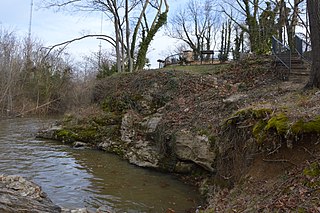 W
WFalling Creek Ironworks was the first iron production facility in North America. It was established by the Virginia Company of London in Henrico Cittie (sic) on Falling Creek near its confluence with the James River. It was short-lived due to an attack by Native Americans in 1622.
 W
WThe first Africans in Virginia were a group of "20 and odd" captives originally from the Kingdom of Ndongo in modern Angola, who arrived in 1619 in the colony of Virginia. They had been part of a larger group heading to Mexico, and were taken after an attack on their Portuguese slave ship by English privateers. Their arrival is seen as a beginning of the history of slavery in Virginia and also as a starting point for African-American history, given that they were the first such group in mainland British America. The 400th anniversary of their arrival was marked by The 1619 Project of The New York Times, the Year of Return in Ghana, and other commemorations.
 W
WFort Christanna was one of the projects of Lt. Governor Alexander Spotswood, who was governor of the Virginia Colony 1710-1722. When Fort Christanna opened in 1714, Capt. Robert Hicks was named captain of the fort and he relocated his family to the area. His homestead "Hick’s Ford" is close to the modern city of Emporia in Greensville County, VA. The fort was designed to offer protection and schooling to the tributary Siouan and Iroquoian tribes living to the southwest of the colonized area of Virginia. Located in what became Brunswick County, Virginia, near Gholsonville, the fort was completed in 1714 and enjoyed three successful years of operation as the westernmost outpost of the British Empire at the time, before being finally closed by the House of Burgesses in 1718. However, the demoralized Saponi and Tutelo continued to live on the allotted land, 6 miles square, into the 1730s and 1740s.
 W
WThe Generall Historie of Virginia, New-England, and the Summer Isles is a book written by Captain John Smith, first published in 1624. The book is one of the earliest, if not the earliest, histories of the territory administered by the London Company.
 W
WGermanna was a German settlement in the Colony of Virginia, settled in two waves, first in 1714 and then in 1717. Virginia Lieutenant Governor Alexander Spotswood encouraged the immigration by advertising in Germany for miners to move to Virginia and establish a mining industry in the colony.
 W
WJamestown was the first settlement of the Virginia Colony, founded in 1607, and served as the capital of Virginia until 1699, when the seat of government was moved to Williamsburg. This article covers the history of the fort and town at Jamestown proper, as well as colony-wide trends resulting from and affecting the town during the time period in which it was the colonial capital of Virginia.
 W
WThe Illinois Country — sometimes referred to as Upper Louisiana — was a vast region of New France claimed in the 1600s in what is now the Midwestern United States. While these names generally referred to the entire Upper Mississippi River watershed, French colonial settlement was concentrated along the Mississippi and Illinois Rivers in what is now the U.S. states of Illinois and Missouri, with outposts in Indiana. Explored in 1673 from Green Bay to the Arkansas River by the Canadien expedition of Louis Jolliet and Jacques Marquette, the area was claimed by France. It was settled primarily from the Pays d'en Haut in the context of the fur trade. Over time, the fur trade took some French to the far reaches of the Rocky Mountains, especially along the branches of the broad Missouri River valley. The French name, Pays des Illinois, means "Land of the Illinois [plural]" and is a reference to the Illinois Confederation, a group of related Algonquian native peoples.
 W
WThe Indian massacre of 1622, popularly known as the "Jamestown massacre", took place in the English Colony of Virginia, in what is now the United States, on Friday, 22 March 1622.
 W
WRhys Llywelyn Isaac was a South African-born Australian historian of American history who also worked in the United States.
 W
WHistoric Jamestown is the cultural heritage site that was the location of the 1607 James Fort and the later 17th-century city of Jamestown. It is located on Jamestown Island, on the James River at Jamestown, Virginia and operated as a partnership between Preservation Virginia and the U.S. National Park Service as part of Colonial National Historical Park.
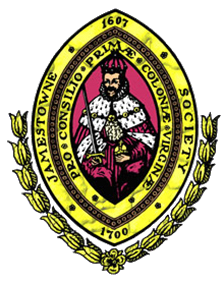 W
WJamestowne Society is an organization founded in 1936 by George Craghead Gregory for descendants of stockholders in the Virginia Company of London and the descendants of those who owned land or who had domiciles in Jamestown or on Jamestown Island prior to the year 1700.
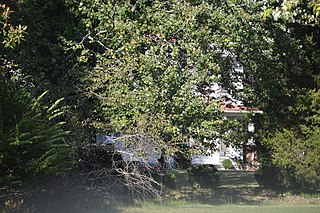 W
WKippax Plantation was located on the south bank of the Appomattox River in what is today the City of Hopewell in southeast Virginia. Kippax Plantation was the home of Colonel Robert Bolling (1646–1709). Bolling married Jane Rolfe, who was the granddaughter of Pocahontas and John Rolfe. Their only child, John Bolling was born at Kippax in 1676, and settled nearby at Cobbs Plantation, just west of Point of Rocks across the Appomattox River in what is now Chesterfield County. While Jane's father Thomas Rolfe (1615–1675) never lived at Kippax Plantation, it is believed that he was buried there, as were Robert and Jane.
 W
WThe Knights of the Golden Horseshoe Expedition, also known as the Transmontane Expedition, took place in 1716 in the British Colony of Virginia. The Royal Governor and a number of prominent citizens traveled westward, across the Blue Ridge Mountains on an exploratory expedition. It is a frequently recounted event of the History of Virginia.
 W
WThe London Company was an English joint-stock company established in 1606 by royal charter by King James I with the purpose of establishing colonial settlements in North America.
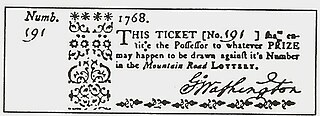 W
WThe Mountain Road Lottery was a project conceived in 1767 by George Washington, Captain Thomas Bullitt, and others. Captain Bullitt had served with Washington in the Virginia Regiment during the French and Indian War (1754–1763). The idea was to build a road through the Allegheny Mountains in Virginia and to construct a resort in the area now known as The Homestead, Hot Springs, Virginia.
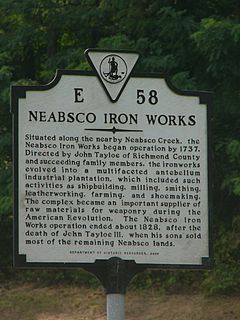 W
WThe Neabsco Iron Works was located in Woodbridge, Virginia, US. It was situated on 5,000 acres (2,000 ha) by the Neabsco Creek.
 W
WThe Ohio Company, formally known as the Ohio Company of Virginia, was a land speculation company organized for the settlement by Virginians of the Ohio Country and to trade with the Native Americans. The company had a land grant from Britain and a treaty with Indians, but France also claimed the area, and the conflict helped provoke the outbreak of the French and Indian War.
 W
WThe "Parson's Cause" was a legal and political dispute in the Colony of Virginia often viewed as an important event leading up to the American Revolution. Colonel John Henry, father of Patrick Henry, was the judge who presided over the court case and jury that decided the issue. The relatively unknown Patrick Henry advocated in favor of colonial rights in the case.
 W
WThe Royal Colonial Boundary of 1665 marked the border between the Colony of Virginia and the Province of Carolina from the Atlantic Ocean westward across North America. The line follows the parallel 36°30′ north latitude that later became a boundary for several U.S. states as far west as the Oklahoma Panhandle, and also came to be associated with the Missouri Compromise of 1820.
 W
WSea Venture was a seventeenth-century English sailing ship, part of the Third Supply mission to the Jamestown Colony, that was wrecked in Bermuda in 1609. She was the 300 ton purpose-built flagship of the London Company and a highly unusual vessel for her day, given that she was the first single timbered, merchantman built in England, and also the first dedicated emigration ship. Sea Venture's wreck is widely thought to have been the inspiration for William Shakespeare's play The Tempest.
 W
WThe Second Virginia Charter, also known as the Charter of 1609, is a document that provided "a further Enlargement and Explanation of the said [first] Grant, Privileges, and Liberties", which gave the London Company adventurers influence in determining the policies of the company, extended the Company's rights to land extending "up into the Land throughout from Sea to Sea", and allowed English merchant companies and individuals to invest in the colonization effort. The charter includes a detailed list of the names of some 650 noblemen, gentlemen, officials, companies, and individuals who subscribed as investors.
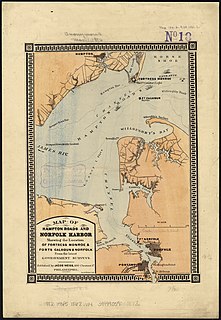 W
WSewells Point is a peninsula of land in the independent city of Norfolk, Virginia in the United States, located at the mouth of the salt-water port of Hampton Roads. Sewells Point is bordered by water on three sides, with Willoughby Bay to the north, Hampton Roads to the west, and the Lafayette River to the south. It is the site of Naval Station Norfolk.
 W
WThe Sparrow-Hawk was a 'small pinnace' similar to the full-rigged pinnace Virginia that sailed for the English Colonies in June 1626. She is notable as the earliest ship known from the first decades of English settlement in the New World to have survived to the present day.
 W
WTobacco and Slaves: The Development of Southern Cultures in the Chesapeake, 1680–1800, is a book written by historian Allan Kulikoff. Published in 1986, it is the first major study that synthesized the historiography of the colonial Chesapeake region of the United States. Tobacco and Slaves is a neo-Marxist study that explains the creation of a racial caste system in the tobacco-growing regions of Maryland and Virginia and the origins of southern slave society. Kulikoff uses statistics compiled from colonial court and church records, tobacco sales, and land surveys to conclude that economic, political, and social developments in the 18th-century Chesapeake established the foundations of economics, politics, and society in the 19th-century South.
 W
WThe Treaty of 1677 was signed in Virginia on May 28, 1677 between Charles II of England and representatives from various Virginia Native American tribes including the Nottoway, the Appomattoc, the Wayonaoake, the Nansemond, the Nanzatico, the Monacan, the Saponi, and the Meherrin following the end of Bacon's Rebellion.
 W
WThe Virginia Company refers collectively to two joint-stock companies chartered under James I on April 10, 1606 with the goal of establishing settlements on the coast of North America. The two companies are referred to as the "Virginia Company of London" and the "Virginia Company of Plymouth", and they operated with identical charters in different territories. The charters established an area of overlapping territory in North America as a buffer zone, and the two companies were not permitted to establish colonies within 100 miles of each other. The Plymouth Company never fulfilled its charter, but its territory was claimed by England and became New England.
 W
WThe Governor's Council was the upper house of the colonial legislature in the Colony of Virginia from 1607 until the American Revolution in 1776. Consisting of 12 men who, after the 1630s were appointed by the British Sovereign, the Governor's Council also served as an advisory body to the Virginia Royal Governor and as the highest judicial body in the colony.
George Washington's Gristmill was part of the original Mount Vernon plantation, constructed during the lifetime of the United States' first president. The original structure was destroyed about 1850. The Commonwealth of Virginia and the Mount Vernon Ladies’ Association have reconstructed the gristmill and the adjacent distillery. The reconstructed buildings are located at their original site three miles (5 km) west of Mount Vernon proper near Woodlawn Plantation in Alexandria, Virginia. Because the reconstructed buildings embody the distinctive characteristics of late eighteenth century methods of production and are of importance to the history of Virginia, the site is listed on the National Register of Historic Places despite the fact that the buildings are not original.
 W
WWilloughby Spit is a peninsula of land in the independent city of Norfolk, Virginia in the United States. It is bordered by water on three sides: the Chesapeake Bay to the north, Hampton Roads to the west, and Willoughby Bay to the south.
 W
W